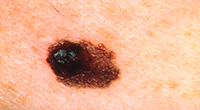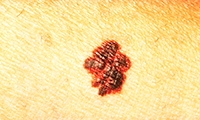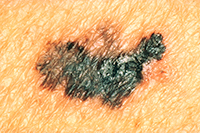Signs & Symptoms of Skin Cancer
Skin cancer is one of the most common types of cancer, and can affect anyone, although there are certain risk factors in play, such as fair skin, family history, and age. Because of this, all of us should be checking ourselves for skin cancer signs and symptoms regularly. We should be aware of the warning signs and know when to see a doctor to have a potential problem looked at.
What Are the Warning Signs of Skin Cancer?
The primary way to spot signs of skin cancer is to do a monthly self check. During this check you should look for the early signs of skin cancer. Knowing your own skin and how it looks is the best way to spot any unusual changes. You may want to get a friend or your partner to help and check those parts of your body which are hard to see, such as your scalp and back.
An easy way to check your skin is to remember the ABCDEs of skin cancer detection:
Asymmetry – Half of the mole or mark doesn’t match the other half.

Border – Irregular, jagged, blurry or notched edges.

Color – Non-uniform color that includes different shades of black, brown, red, white, pink or blue patches.

Diameter – The growth is more than ¼ inch in diameter (about the size of a pencil eraser.)

Evolving – The mole is growing or changing color or shape.
If you notice something irregular, don’t hesitate to make an appointment with your doctor to further investigate. Your doctor will look in depth for signs of skin cancer. What the mark looks like will tell your doctor more about what type of skin cancer it could be.
Basal and Squamous Cell Carcinomas Signs
Basal and squamous cell carcinomas are most often found on areas of your skin that are exposed to the sun regularly, but can develop anywhere. Signs of basal and squamous cell carcinomas could be:
- Flat yellow areas that look like a scar, but with no associated injury.
- Rough, scaly, or raised red patches that are itchy or inclined to bleed.
- Raised growths or lumps, sometimes with a pit in the center. If it is basal cell, then they may have blood vessels looking like the spokes of a wheel.
- Small pink or red bumps which are translucent and may have blue, brown, or black areas within them.
- Warts
- Open sores that either refuse to heal or keep coming back.
This form of cancer is very common and very treatable. However, once you have had one instance, you are likely to have others, so you should be particularly careful about checking your skin after a carcinoma has been treated.
Melanoma Signs
Melanoma is less common, but more dangerous. Melanoma tends to spread to other parts of the body if not detected and treated early. Signs of melanoma are:
- A mole that develops later in life or an existing mole changing in size, shape, or color. Moles that are larger than 1/4 inch across can also be a red flag, as can ones which have an irregular border or color variations. A mole you have had all your life can sometimes become cancerous, so you should check your moles for changes frequently.
- Sores that refuse to heal.
- A spot that is expanding into the surrounding skin.
- Redness or swelling around a mole.
- A mole becoming itchy or painful.
- Scaliness, oozing, or bleeding on the surface of a mole.
If in doubt, your doctor may choose to remove an apparently innocent mole rather than take the risk.
Skin cancer sometimes manifests differently for people with darker skin tones. Unfortunately, it’s a myth that having dark skin will protect you from skin cancer, which sometimes causes darker-skinned people to miss cancer in its early stages. If you have dark skin, you should pay special attention to spots on your hands, the soles of your feet, and under your nails. This can indicate a particularly bad form of melanoma.
What to Do if You Find Signs of Skin Cancer?
You should be examined by your doctor if you find anything that might be a sign of skin cancer. It is better to be safe, and if it turns out not to be cancer, then you will have peace of mind.
A skin cancer specialist may be able to tell whether the mark is cancerous or not without a biopsy. However, if they are at all suspicious that the mark may be cancer, they will perform a skin biopsy, and may remove the suspicious area (this is called an excisional biopsy). In most cases the lab will make a diagnosis by having a skin cancer specialist view the tissue under a microscope. If the cancer has been detected early enough, a dermatologist may be able to treat it. If not, they will refer you to a skin cancer oncologist.
Skin cancer is one of the most common forms of cancer, so we should all be checking our skin regularly for changes and lesions that might indicate cancer. If you find a suspicious area, seek medical attention. In most cases, if skin cancer is found early, it is easily treatable without further problems or unpleasant side effects.


